Understanding Red Hot Chilli Peppers
Red hot chilli peppers aren't a single variety but rather represent the mature stage of many chilli types that turn red when fully ripened. As chillies mature from green to red, their capsaicin content (the compound responsible for heat) increases while developing more complex sugars and flavors. This transformation creates the distinctive red hot chilli pepper varieties comparison that chefs and home cooks prize for their culinary versatility.
The term "red hot" specifically refers to both the color and heat level. Not all red chillies qualify as "hot"—some sweet bell peppers also turn red but contain negligible capsaicin. True red hot varieties maintain significant heat while developing their characteristic color.
Heat Measurement and Scoville Scale
Understanding the red hot chilli pepper Scoville scale ratings helps determine appropriate usage. The Scoville scale measures capsaicin concentration, with higher numbers indicating greater heat intensity. Most red hot varieties fall within these ranges:
| Chilli Variety | Scoville Heat Units | Flavor Profile |
|---|---|---|
| Cayenne | 30,000-50,000 SHU | Sharp, slightly smoky |
| Bird's Eye | 50,000-100,000 SHU | Grassy, citrusy |
| Serrano (red) | 10,000-23,000 SHU | Bright, fresh |
| Habanero (red) | 100,000-350,000 SHU | Fruity, floral |
| Red Savina Habanero | 350,000-580,000 SHU | Sweet, tropical |
When selecting peppers for recipes, consider both heat level and flavor characteristics. The red hot chilli pepper varieties comparison shows how each brings unique qualities beyond mere spiciness.

Culinary Applications
Chefs worldwide value red hot chillies for their ability to add both heat and complex flavor. Unlike their green counterparts, fully ripened red varieties offer cooking with red hot chilli peppers opportunities that balance intense heat with nuanced taste profiles.
Traditional applications include:
- Thai cuisine using bird's eye chillies in curries and dipping sauces
- Mexican salsas and mole sauces featuring arbol or de árbol chillies
- Caribbean hot sauces made with scotch bonnet peppers
- Indian vindaloo and other spicy curry preparations
- African peri-peri sauces using African bird's eye chillies
When cooking with red hot chilli peppers, remember that heat distributes unevenly—seeds and white membranes contain the highest capsaicin concentrations. For controlled heat, remove these elements before cooking. Always wash hands thoroughly after handling and avoid touching your face.
Health Benefits and Considerations
Research into the health benefits of red hot chilli peppers reveals several potential advantages. Capsaicin has been studied for its metabolism-boosting properties, pain relief capabilities, and potential cardiovascular benefits. Red chillies also provide significant vitamin C (higher than oranges by weight) and vitamin A.
However, certain precautions are necessary:
- Consumption may trigger heartburn or digestive discomfort in sensitive individuals
- Direct skin contact can cause irritation—use gloves when handling extremely hot varieties
- Those with gastrointestinal conditions should consult physicians before regular consumption
- Never inhale powdered chilli—can cause severe respiratory irritation
For safe enjoyment, start with small amounts and gradually increase tolerance. The how to handle extremely hot chilli peppers properly begins with protective gear and proper ventilation when preparing them.

Growing Your Own Red Hot Chilli Peppers
Many gardeners enjoy growing red hot chilli peppers at home for fresh culinary use. These plants thrive in warm climates but can grow in containers in cooler regions. Key considerations include:
- Start seeds indoors 8-10 weeks before last frost date
- Provide 6-8 hours of direct sunlight daily
- Maintain consistent moisture without waterlogging
- Allow peppers to fully ripen to red on the plant for maximum heat and flavor
- Harvest by cutting stems rather than pulling peppers
Patience is essential—many hot varieties take 80-100 days to reach full red ripeness. The wait rewards growers with significantly more complex flavors compared to green-harvested peppers.
Common Misconceptions
Several myths surround red hot chillies. Contrary to popular belief, the hottest part isn't the seed but the placental tissue surrounding seeds. Milk effectively neutralizes capsaicin (not water, which spreads it). And while heat tolerance can increase with exposure, it doesn't eliminate potential digestive irritation for sensitive individuals.











 浙公网安备
33010002000092号
浙公网安备
33010002000092号 浙B2-20120091-4
浙B2-20120091-4